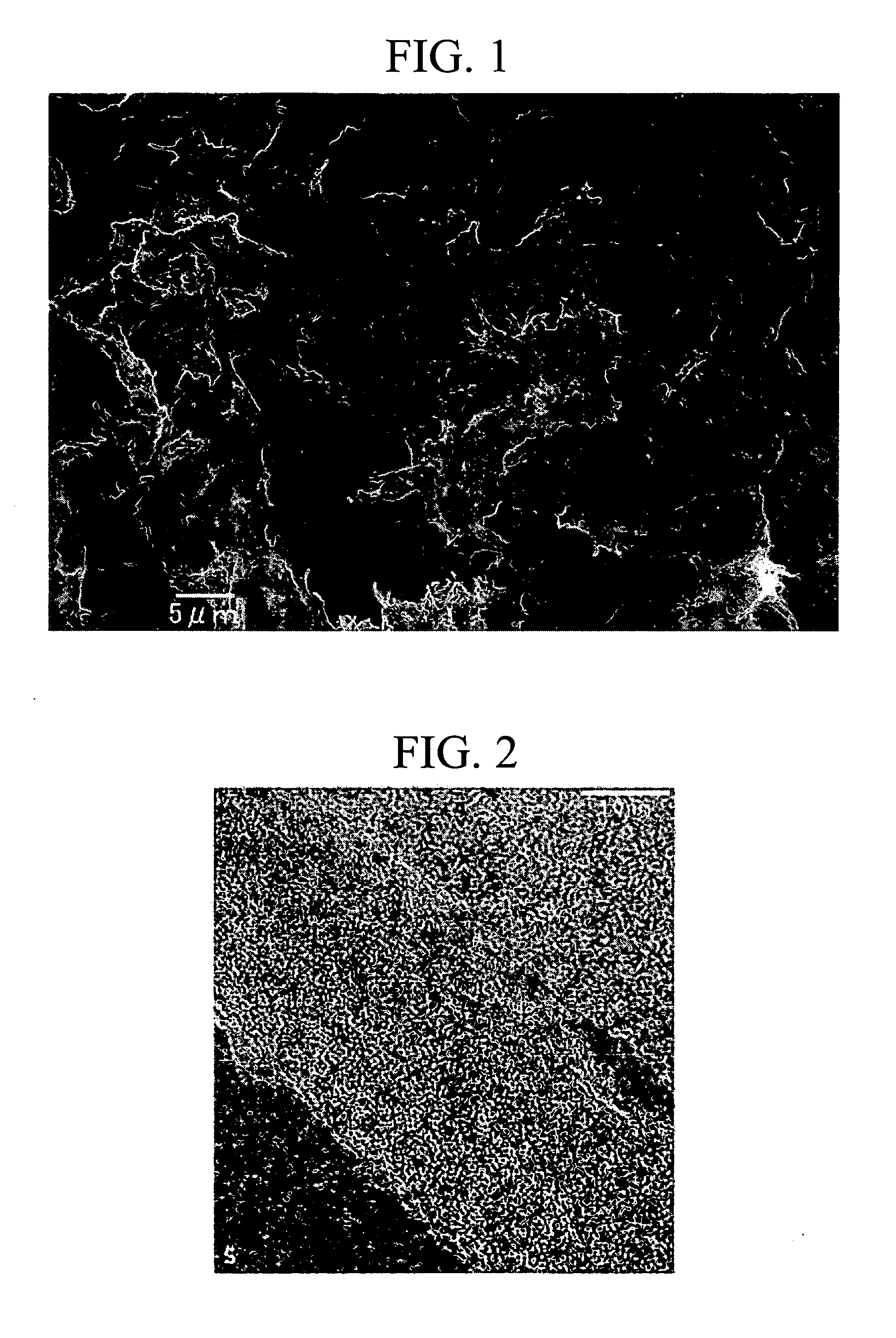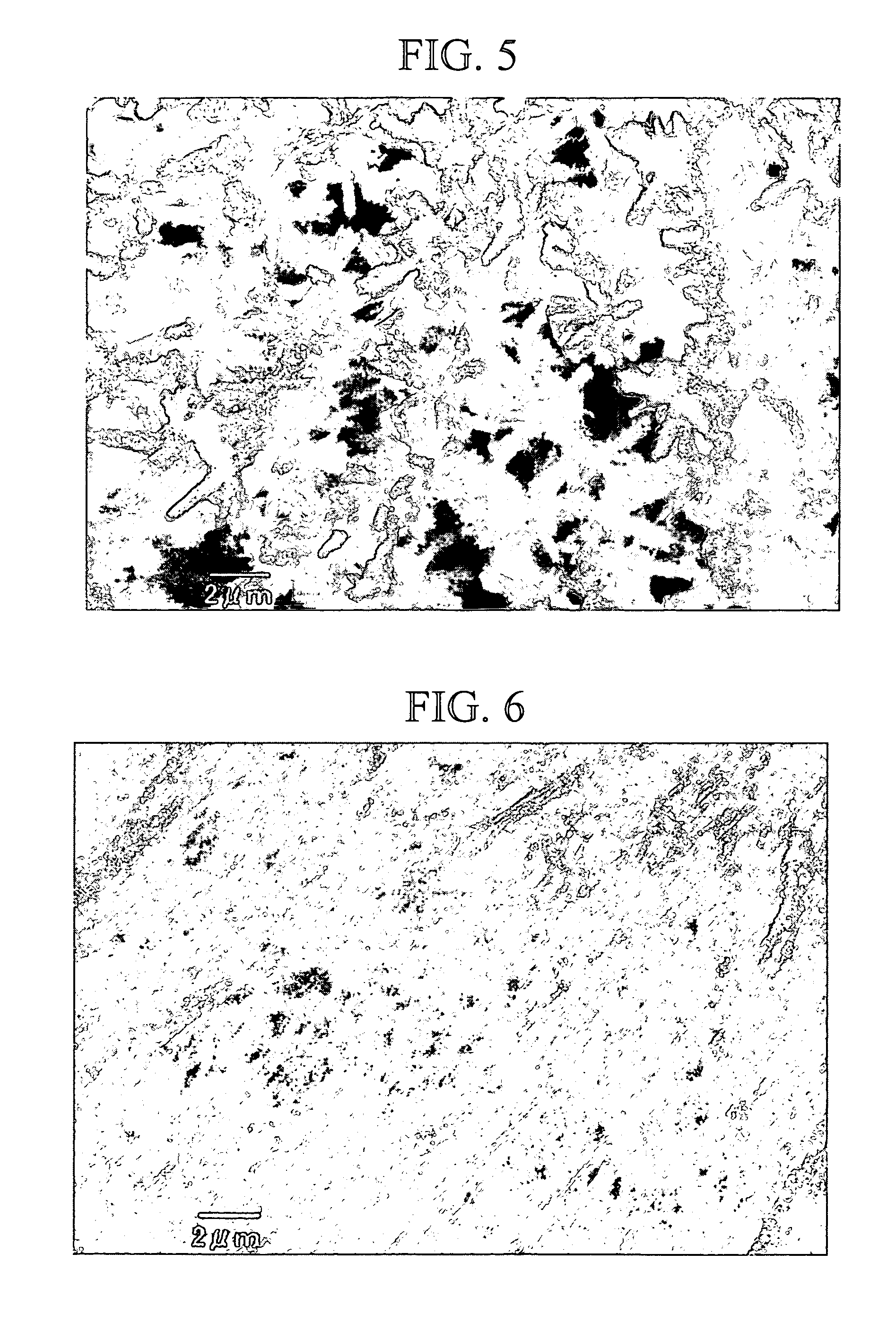Organic-inorganic hybrid nanofiber, organic-inorganic hybrid structure, and method for producing the same
a hybrid nanofiber and organic technology, applied in the field of organic-inorganic hybrid nanofibers, can solve the problems of unavoidable crystallization of polyethyleneimine chains, achieve the effects of easy cationation, easy grafting with other polymers, and large surface area
- Summary
- Abstract
- Description
- Claims
- Application Information
AI Technical Summary
Benefits of technology
Problems solved by technology
Method used
Image
Examples
synthesis example 1
[0132] Synthesis of Linear Polyethyleneimine (L-PEI)
[0133] A commercially available polyethyloxazoline (number average molecular weight=500,000, mean degree of polymerization=5,000, manufactured by Aldrich Corp.), in an amount of 5 g, was dissolved in 20 mL of a 5 M aqueous solution of hydrochloric acid. The solution was heated to 90° C. in an oil bath, and was stirred for 10 hours at the same temperature. Acetone, in an amount of 50 mL, was added to the reaction mixture to completely precipitate a polymer. The polymer was filtered, and washed with methanol three times. As a result, a white powder of polyethyleneimine was obtained. The obtained powder was identified by means of 1H-NMR (deuterated water). As a result, it was confirmed that the peaks at 1.2 ppm (CH3) and 2.3 ppm (CH2) assigned to the ethyl group of the side chain of the polyethyloxazoline completely disappeared. In other words, this result indicated that the polyethyloxazoline was completely hydrolyzed and was conver...
synthesis example 2
[0135] Synthesis of Linear Polyethyleneimine (L-PEI-2)
[0136] A commercially available polyethyloxazoline (number average molecular weight=50,000, mean degree of polymerization=500, manufactured by Aldrich Corp.), in an amount of 30 g, was dissolved in 125 mL of a 5 M aqueous solution of hydrochloric acid. The solution was heated to 100° C. in an oil bath, and was stirred for 12 hours at the same temperature. Acetone, in an amount of 150 mL, was added to the reaction mixture, and a polymer was completely precipitated. The precipitated polymer was filtered, and washed with acetone three times. As a result, a white powder of a hydrochloride salt of a polyethyleneimine was obtained. The obtained powder was identified by means of 1H-NMR (deuterated water). As a result, it was confirmed that the peaks at 1.2 ppm (CH3) and 2.3 ppm (CH2) assigned to the ethyl group of the side chain of the polyethyloxazoline completely disappeared. In other words, this result indicated that the polyethylox...
synthesis example 3
[0138] Synthesis of Polyethyleneimine Having Porphyrin as a Center in the Form of a Star (P-PEI)
[0139] In accordance with a method described in Jin et al., J. Porphyrin & Phthalocyanine, 3, 60-64 (1999); and Jin, Macromol. Chem. Phys., 204, 403-409 (2003), a polymethyloxazoline having a center of porphyrin in the form of a star as a precursor polymer was synthesized as described below.
[0140] The inside of a two-neck flask with a volume of 50 mL equipped with a three-way tap was displaced with an argon gas. Subsequently, 0.0352 g of tetra(p-iodomethylphenyl)porphyrin (TIMPP), and 8.0 mL of N,N-dimethylacetamide were added thereto. The mixture was stirred at room temperature, and TIMPP was completely dissolved. To the solution, 2-methyl-2-oxazoline, in an amount of 3.4 mL (3.27 g), corresponding to 1280 times mole of the porphyrin was added. Subsequently, the temperature of the reaction mixture was increased to 100° C., and was stirred for 24 hours. The reaction mixture was cooled t...
PUM
| Property | Measurement | Unit |
|---|---|---|
| diameter | aaaaa | aaaaa |
| diameter | aaaaa | aaaaa |
| temperature | aaaaa | aaaaa |
Abstract
Description
Claims
Application Information
 Login to view more
Login to view more - R&D Engineer
- R&D Manager
- IP Professional
- Industry Leading Data Capabilities
- Powerful AI technology
- Patent DNA Extraction
Browse by: Latest US Patents, China's latest patents, Technical Efficacy Thesaurus, Application Domain, Technology Topic.
© 2024 PatSnap. All rights reserved.Legal|Privacy policy|Modern Slavery Act Transparency Statement|Sitemap



